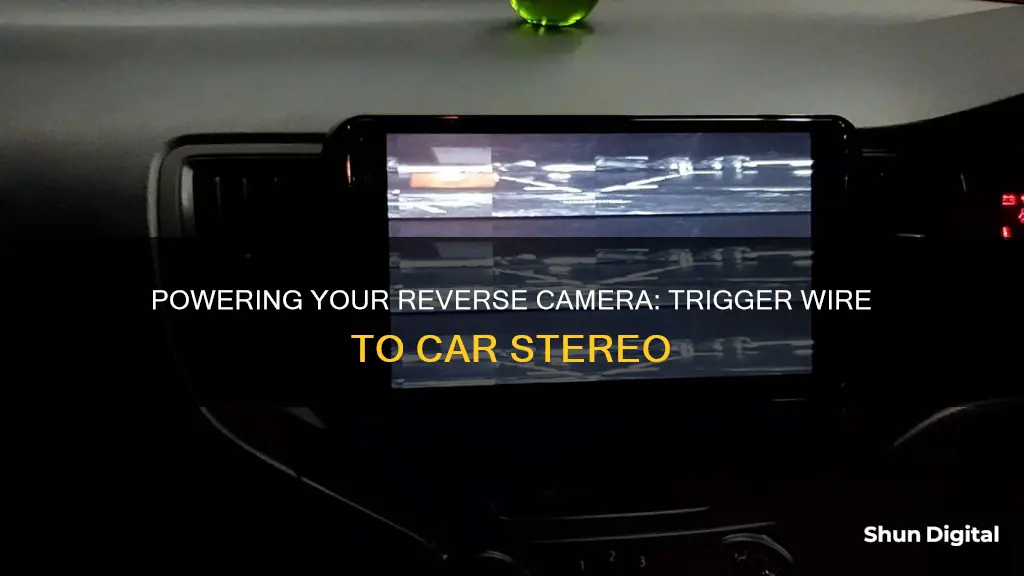
To power a reverse camera to car stereo trigger wires, you need to understand the components of a standard backup camera system. The monitor will have a single cable that connects to a power harness with video inputs and power connections. The power harness will have RCA video inputs, audio inputs, a positive power lead, a ground connection, and a trigger wire. The camera will have a similar setup with a DC power plug input for power. The power harness for the camera will have a male DC power connector to bare power leads. The RCA cable will transmit the video feed from the camera to the monitor.
The first step is to connect the power harness to the monitor's power input. Then, connect the red wire to the 12-volt power source and the black wire to the ground. Next, connect the male power harness to the camera's female power input. After that, connect the red wire to the 12-volt power or the positive side of the reverse lights, and the black wire to the ground. Finally, connect the camera to the monitor using the RCA cable.
| Characteristics | Values |
|---|---|
| Monitor Power Cable Connections | Connect the red wire to 12 volt power and the black to ground |
| Trigger Wire Operation | Default installation is to connect to the positive side of the reverse light. For manual operation, leave this disconnected |
| Bare Lead Monitor Power Connections | Connect the red wire to 12 volt power or the positive side of the reverse lights and the black to ground |
| Camera Power Connections | Connect the red wire to 12 volt power or the positive side of the reverse lights and the black to ground |
| RCA Cable Connections | Connect the camera to the monitor using the standard yellow RCA cable |
| Backup Camera Power Supply | Connect the positive and negative power supply wire of the reverse camera with the positive and negative leads of the backup light |
| Backup Camera Video Cable | Connect the reverse camera video cable with the reverse camera RCA video input cable from the radio harness |
| Backup Camera Detecting Lead | Connect the reverse camera detecting lead (blue or orange/white in different models) from the radio harness with the positive terminal of the backup light |
| Trigger Wire | If there is no trigger wire from the video cable, you will need an extension wire to connect the reverse camera detecting lead and the positive terminal of the backup light |
What You'll Learn
- Connect the positive and negative power supply wire of the reverse camera to the positive and negative leads of the backup light
- Connect the reverse camera video cable to the RCA video input cable from the radio harness
- Connect the reverse camera detecting lead to the positive terminal of the backup light
- Connect the red wire to 12V power and the black wire to ground
- Connect the male power harness to the camera's female power input

Connect the positive and negative power supply wire of the reverse camera to the positive and negative leads of the backup light
To connect the positive and negative power supply wire of the reverse camera to the positive and negative leads of the backup light, follow these steps:
Firstly, locate the positive and negative power supply wires of the reverse camera. These wires are typically colour-coded, with the positive wire being red and the negative wire being black. Now, locate the positive and negative leads of the backup light on your vehicle. These leads will also be colour-coded, with the positive lead typically being red and the negative lead being black or having a (-) symbol.
Now, you are ready to make the connections:
- Connect the positive power supply wire (red) from the reverse camera to the positive lead of the backup light. Ensure that both connectors are securely fastened and colour-coded correctly to avoid any electrical issues.
- Connect the negative power supply wire (black) from the reverse camera to the negative lead of the backup light. Again, ensure secure connections and proper colour-coding.
By making these connections, you are providing power to the reverse camera through the backup light circuit. This means that the reverse camera will turn on when the backup light is activated, providing you with a clear view when reversing your vehicle.
It is important to note that you should not connect the power supply wire of the reverse camera to the brake light or tail light circuits, as this could lead to incorrect functionality. Always refer to your vehicle's wiring diagram or consult a professional if you are unsure about the wiring connections.
Freeing Stuck Batteries in Pentax Cameras
You may want to see also

Connect the reverse camera video cable to the RCA video input cable from the radio harness
To connect the reverse camera video cable to the RCA video input cable from the radio harness, begin by locating the video cable attached to the reverse camera. This cable should have an RCA connector, which is typically colour-coded yellow. Proceed to locate the corresponding RCA video input cable from the radio harness, ensuring it is specifically intended for the reverse camera or back camera input.
It is crucial to distinguish the RCA video input cable from the radio harness and avoid connecting it to the Video-in RCA input cable from the radio, as this could lead to incorrect functionality. Once you have identified the correct RCA video input cable, securely connect the reverse camera video cable to it. This connection allows the video signal from the reverse camera to be transmitted to the radio harness and displayed on the head unit or infotainment system.
In some cases, the reverse camera video cable may include a trigger wire that needs to be extended to the positive terminal of the backup light. This trigger wire ensures that the radio or head unit automatically switches to the reverse camera input mode when the backup light is turned on. If such a wire is absent, an extension wire may be required to establish the connection between the reverse camera detecting lead and the positive terminal of the backup light.
It is important to note that the power supply wire of the reverse camera should be connected to the positive and negative leads of the backup light (reverse light) and not to the brake light or tail light. Additionally, always refer to the specific instructions and wiring diagrams provided with your reverse camera kit for a more detailed guide on connecting the reverse camera video cable to the RCA video input cable from the radio harness.
Smartphone Camera Focus Lock: How to Engage It
You may want to see also

Connect the reverse camera detecting lead to the positive terminal of the backup light
To connect the reverse camera detecting lead to the positive terminal of the backup light, follow these steps:
Firstly, locate the reverse light wire. This can usually be found by tracing the wire from the reverse light itself, or by referring to your vehicle's wiring diagram. The wire colour may vary, but it is typically red or blue.
Once you have located the reverse light wire, you need to identify the positive terminal. This is usually denoted by a "+" symbol or a red colour. With the positive terminal identified, you can now connect the reverse camera detecting lead.
The reverse camera detecting lead is typically blue or orange/white, depending on the model of your car stereo and reverse camera. It is important to note that some reverse cameras may have a trigger wire attached to the video cable, which can be used to extend the detecting lead to the positive terminal of the backup light. If your reverse camera does not have a trigger wire, you will need to use an extension wire to make this connection.
This connection is crucial for the automatic activation of the reverse camera when the vehicle is shifted into reverse. When the radio detects voltage from the backup light, it will automatically switch to the reverse camera input mode.
It is important to note that in some car models, the positive terminal of the backup light may be constantly powered. In such cases, you may need to use a relay to ensure that the stereo does not remain in reverse mode all the time.
By following these steps and ensuring the correct connections, you will be able to successfully connect the reverse camera detecting lead to the positive terminal of the backup light, allowing for seamless activation of your reverse camera when needed.
Disputing Camera Red-Light Tickets in NY: Know Your Rights
You may want to see also

Connect the red wire to 12V power and the black wire to ground
To power a reverse camera to car stereo trigger wires, you need to connect the red wire to 12V power and the black wire to ground. This is because, in a 12V DC automotive context, red wires are typically positive, and black wires are negative.
In the case of a reverse camera, the red wire is connected to the positive terminal of the reverse light, which provides the power source. The black wire, on the other hand, is connected to the negative or ground terminal of the reverse light. This ensures that the camera receives the necessary electrical current to function properly.
It is important to note that the wiring process may vary depending on the specific make and model of your vehicle, as well as the type of reverse camera and stereo system you are using. Always refer to the manufacturer's instructions or consult a qualified car audio installer for guidance on the correct wiring procedure for your particular setup.
Additionally, when working with automotive electrical systems, it is crucial to exercise caution and follow proper safety procedures to avoid any potential hazards. Ensure that the vehicle's battery is disconnected before beginning any wiring work, and always verify that the power is off using an electrical tester.
In the context of your reverse camera installation, connecting the red wire to 12V power means linking it to the positive terminal of the reverse light. This can typically be achieved by locating the reverse light bulb or housing and identifying the relevant wiring. The specific process may vary depending on your vehicle's make and model, so it is recommended to refer to a wiring diagram or seek advice from a professional installer.
As for the black wire, connecting it to ground involves attaching it to a suitable grounding point in your vehicle's electrical system. This could be a metal part of the car's chassis or a designated ground terminal. Again, the exact location and method may differ depending on your vehicle, so it is important to consult a professional or refer to vehicle-specific instructions.
By following these steps and ensuring proper connections, you can provide the necessary power and ground for your reverse camera, allowing it to function correctly and provide you with a clear view when reversing your vehicle.
Unveiling Car Rooftop Cameras: A Comprehensive Guide
You may want to see also

Connect the male power harness to the camera's female power input
To connect the male power harness to the camera's female power input, you will need to follow these steps:
Firstly, locate the correct wires. The power harness should include a 12-volt power lead, typically coloured red, and a ground lead, typically coloured black. The camera's female power input will usually be a DC power connection, also with a 12-volt power pin.
Secondly, ensure you have the correct tools for the job. You will need a basic understanding of electronics and automotive wiring, as well as the necessary tools such as wire strippers, electrical tape, and a voltage tester.
Now, you can begin the connection process. Strip the insulation from the ends of the male power harness wires, exposing the copper wire. Twist these bare wires together with their corresponding female power input wires, ensuring a tight connection. You may wish to solder these connections for added security, although this is not strictly necessary.
Finally, insulate your connections. Wrap each joined pair of wires with electrical tape to prevent short circuits and ensure a secure connection. Use your voltage tester to check that the connection is working and providing power to the camera.
By following these steps, you will successfully connect the male power harness to the camera's female power input, providing the necessary power for your reverse camera to function.
Who Created the First Electric Camera?
You may want to see also
Frequently asked questions
Connect the positive and negative power supply wire of the reverse camera to the positive and negative leads of the backup light (reverse light).
You will need a reverse camera RCA cable, which is usually yellow and used for video association. This will trigger the monitor from the camera.
A reverse trigger wire is usually connected to the same point where the camera is powered. The car head-unit switches to reverse mode when it receives a reverse signal from the reverse trigger wire.
The power harness is a DC power connection that includes a 12-volt power lead and a black ground lead. Connect the red wire to a 12-volt power supply and the black wire to the ground.







